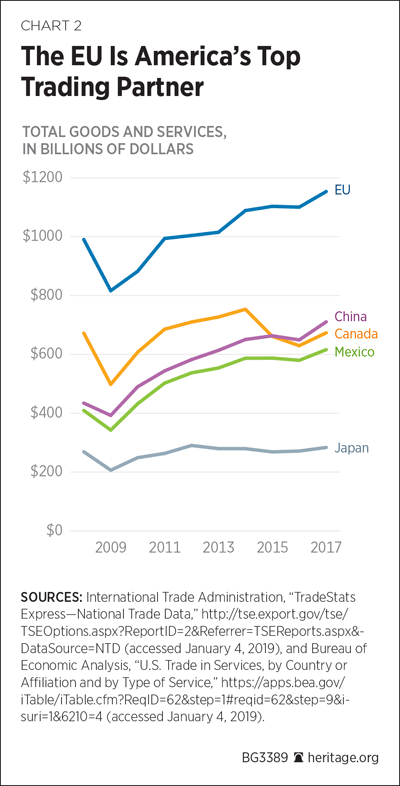In the eyes of many European observers, the United States’ imposition of tariffs on a range of products exported by European Union countries to the U.S.—and the U.S. threat to impose even more tariffs on additional categories (especially cars)—has called into question the fundamental free-market principles and shared Western values that have undergirded the postwar transatlantic partnership.
These principles had a special significance for Europe, where they underpinned transatlantic unity while Western Europe was slowly rebuilding and motivated former Soviet satellites in Central and Eastern Europe to embrace the free-market system.
Americans for their part have viewed hostile steps by the European Commission against American companies, especially those that trade in services and data, with growing concern. The contentious approach to Brexit negotiations by the EU governing bodies has been equally troubling, especially in view of the potential benefits to the American economy from a possible U.S.–U.K. free trade agreement. In addition, the wider EU approach of imposing costs on producers and consumers by regulations “behind the border” (instead of levying tariffs at the border) represents a new and ominous twist on traditional non-tariff barriers.
This Backgrounder presents an in-depth examination of the composition of U.S.–EU trade and how it is affected by tariffs levied or proposed by both sides, as well as by European protectionism in high-technology sectors. The recommendations in this Backgrounder are aimed at actions that the United States and the European Union can take to end the U.S.–EU trade war before it gets any worse, by:
- Beginning formal negotiations to explore prospects for the “Zero-Zero-Zero” U.S.–EU trade agreement to eliminate all tariffs as President Donald Trump proposed at the G-7 meeting in 2018, or alternatively, attempting to finalize some of the sectoral agreements that were part of the Transatlantic Trade and Investment Partnership (TTIP) talks during the Obama Administration;
- Agreeing to roll back existing obstructions imposed by Brussels on American high-tech companies (for instance in Silicon Valley) accompanied by a pledge not to impose new barriers or otherwise harass U.S. high-tech companies;
- Improving the World Trade Organization’s (WTO’s) dispute resolution processes and ending the U.S.’s practice of blocking judicial appointments to the WTO’s appellate body; and
- Defining strategies wherein the EU would work with the U.S. to adopt a united front in the face of predatory trade practices by China.
U.S.–EU trade: By the Numbers
The 28 member countries (including the U.K.) of the European Union are vital U.S. allies and, as a single entity, the EU is America’s largest trading partner, with China, Canada, and Mexico close behind. The overall 2017 trade turnover between the U.S. and the EU bloc constituted over $1 trillion (around $1.1 trillion in 2014, 2015, and 2016). According to U.S. data, in 2017, the U.S. exported goods worth $283 billion to EU countries and imported goods worth $435 billion.REF In the meantime, data from the U.S. Bureau of Economic Analysis show a consistent surplus in America’s export of services. In 2017, the U.S. exported $243 billion in services to the EU, while importing services worth $192 billion.
Even after the United Kingdom departs the European Union in 2019, the 27-member EU entity will continue to be the largest single U.S. trade partner, with an estimated $850 billion to $900 billion in annual bilateral trade.
An analysis of the composition of total U.S.–EU trade in goods reveals a picture of two economically similar global regions that trade in the same categories of goods. Four of the five categories of goods most heavily traded are identical: Harmonized Tariff Schedule (HTS) codes 30, 84, 85, and 90. The fifth category is different: The U.S. exports more aircraft to the EU (HTS code 88) and imports more vehicles (HTS code 87).
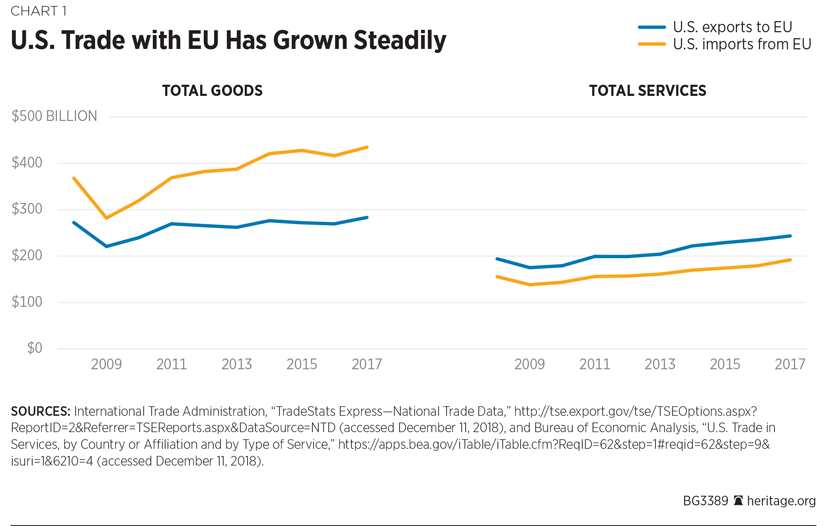
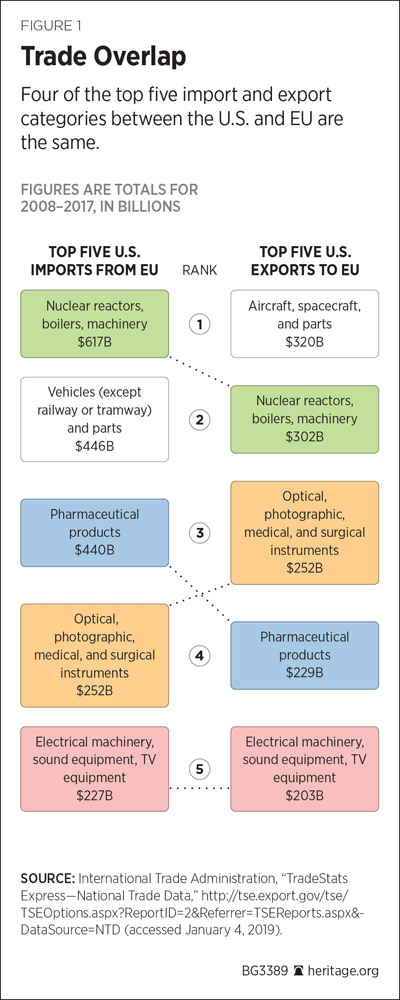
The breakdown of trade in services also looks broadly balanced. Both sides import and export mainly transportation services (predominantly for air transportation), followed by financial services, travel services, and royalties for the use of intellectual property.
In the individual services categories, the U.S. has the greatest surplus in exporting services related to the use of intellectual property ($27.4 billion) and financial services ($21.3 billion), while the EU has the greatest surplus in transport services ($9.3 billion).REF
New U.S. Tariffs on Imports from the EU
In March 2018, the Trump Administration, under the authority of Section 232 of the Trade Expansion Act of 1962,REF imposed 25 percent tariffs on imports of steel from the EU.REF Prior to that, the tariffs were either zero percent or negligible, depending on the particular product code.REF While the steel tariffs were imposed globally,REF they affected mainly the EU, being the largest single exporter of steel to the United States.
In 2017, the value of total U.S. imports of those steel products that became subject to the new tariffs amounted to $5.993 billion (out of around $10.6 billion of overall imports of iron and steel and products made from these materials).REF Over the past 10 years, the value of U.S. imports of these steel products from the EU has fluctuated from as high as $8.6 billion in 2014 to as low as $4.9 billion in 2016.
The Trump Administration also added a 10 percent tariff to existing 3 percent to 6 percent ad valorem tariffs on aluminum.REF In 2017, the value of total imports of the aluminum HTS codes that became subject to the extra tariff was $1.4 billion. Like steel, over the past 10 years, these imports have fluctuated from a low of $873 million in 2009 to a high of $1.4 billion in 2017.
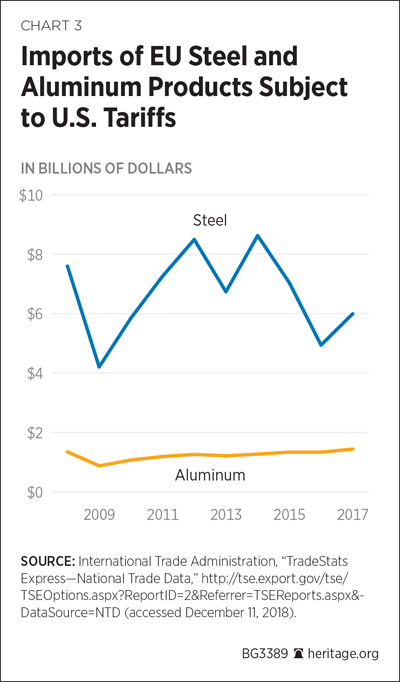
Cautious EU Countermeasures
The EU has retaliated with a reciprocal response to the U.S. tariffs. The European Commission—the EU body responsible for the common external trade policy of the bloc—actually imposed tariffs that were disproportionately lower in the aggregate. But the EU purposefully targeted highly visible and symbolic American products, those that had readily available substitutes in the EU and that were produced, not by coincidence, in the home states of senior members of the U.S. Congress. They included Harley–Davidson motorcycles from Wisconsin, peanut butter, Kentucky bourbon, and Levi’s jeans.
In particular, the EU put together two separate lists of goods.REF The first list (Annex I) contains 182 product categories whose imports from the U.S. amounted to €2.8 billion ($3.2 billion) in 2017. The extra tariffs on items on this list is generally 25 percent (except for some items with 10 percent tariffs). The second list (Annex II) contains 158 product codes whose imports amounted to €3.8 billion ($4.3 billion) in the same year. The extra tariffs on products listed in Annex II will range from 10 percent to 50 percent.
Annex I entered into force on June 22, 2018, as a countermeasure to the U.S. steel tariffs, while Annex II will begin to apply either in 2021 or earlier, in the event of a ruling that the U.S. tariffs are in violation of WTO rules.
Meanwhile, the EU launched a diplomatic counter-offensive, sending EU President Jean-Claude Juncker to meet with President Trump in Washington, where the two leaders agreed to work toward zero tariffs on non-auto industrial goods and reduce barriers and increase trade in services, chemicals, pharmaceuticals, medical products, and soybeans.REF Juncker promised that it will be EU policy in this trade dispute with the U.S. to lift the tariffs as soon as the United States lifts its own tariffs on EU products.
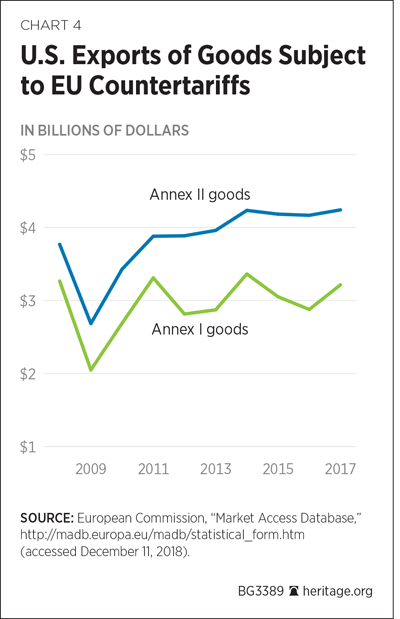
While bickering with the U.S., the EU continues to pursue expansion of its network of free trade agreements with other major advanced economies. Talks between the EU and Japan on trade liberalization started in 2013 and were finalized in December 2017.REF Also in 2017, the Comprehensive Economic and Trade Agreement (CETA) between the EU and Canada entered into force; it should save EU businesses up to €590 million ($665 million) a year.REF In April 2018, the EU finalized negotiations on a free trade agreement with Mexico which—once ratified by the EU member states—will make practically all trade between the EU and Mexico duty-free.REF Meanwhile, the EU has opened free trade talks with Australia.REF
The European Commission has also come up with a list of proposed changes to the WTO dispute-resolution process, which may have been motivated by U.S. complaints and which are intended to resolve or at least mitigate them.REF
Calculating the Impact of Tariffs on the EU and U.S. Economies
Steel and aluminum tariffs affect individual steel and aluminum exporters in the EU, such as Germany’s ThyssenKrupp or Austria’s Voestalpine, which have already reported negative financial impacts from the U.S. tariffs. Nevertheless, to date their share prices have not been noticeably impacted adversely.REF
The market-distorting and seemingly arbitrary exclusions from the tariffs granted by the U.S. Commerce Department have been another complicating factor, in addition to the impact of the steel and aluminum tariffs themselves.REF Understaffed and overwhelmed by the sheer number of exclusion requests filed by American importers who face higher input prices, the Commerce Department seems to arrive at contradictory conclusions on products with very similar descriptions that require basically the same technology and skills to produce. This unpredictability has led to chaos in the marketplace and has made planning by U.S. manufacturers accustomed to using imported steel and aluminum more difficult.
Hence, the U.S. tariffs and European countermeasures have combined to deliver a double-whammy punch to the bottom lines of some American firms. For instance, the EU counter tariffs may cost Harley–Davidson as much as $45 million for the remainder of 2018 and $90 million to $100 million in 2019REF—in addition to an extra $15 million to $20 million that Harley–Davidson has been forced to pay for imported steel and aluminum used for production due to their increased prices.REF S&P 500 companies in the United States, such as Ford Motor Company and Whirlpool, may be similarly affected.REF
Regarding Kentucky bourbon and other American-made whiskies, the price elasticity of spirits is estimated at approximately –0.55,REF which means that a 25 percent extra tariff should lower its demand by around 14 percent. Given that from 2013 to 2017 the EU imported American-made spirits worth $606 million per year on average,REF the extra 25 percent tariff could result in a loss of revenue due to lower sales, or an increase in export costs due to the tariff in the amount of roughly $85 million annually (about $7 million per month).REF The lost revenue due to higher export costs or lower sales of goods such as American peanut butter,REF blue jeans, and beauty products will be smaller and may amount to just a few million dollars per year.
As bad as these impacts are, they are dwarfed by the potential consequences of new U.S. tariffs on autos currently under consideration in the U.S. The Trump Administration is currently investigating under Section 232 of the U.S. Trade Expansion Act to determine if “automotive imports pose a threat to national security.”REF A U.S. tariff of 25 percent already applies to foreign-made SUVs and light trucks.REF
Between 2008 and 2017, the EU exported to the U.S. on average $34.6 billionREF in automobiles annually, much more than the combined total of EU steel and aluminum exports. The main exporter is Germany. Automobile exports to the U.S. from the EU amounted to $44.4 billion in 2017, of which nearly half ($20.5 billion) were from Germany.
Given the long-run car price elasticity of –0.2, a 20 percent U.S. tariff might decrease the long-run U.S. imports of European cars by some $2 billion. For European vehicles that are imported, U.S. consumers would absorb a portion of the tariff burden by paying $5,800 more per vehicle, according to some estimates.REF In the other direction—if the EU were to retaliate by imposing an additional 10 percent tariff on top of the currently existing 10 percent levy to match the total U.S. tariff—it might cost U.S. auto manufacturers some $1.1 billion annually (roughly $92 million per month) in immediately lost exports of U.S.-built vehicles to the EU.
Unfortunately, because there is no provision that mandates it under Section 232, there will be no comprehensive study by the U.S. International Trade Commission to calculate the total impact of the proposed U.S. automotive tariffs.REF
Any Agreement Must Address EU Harassment of U.S. High-Tech Companies
In timing that could not have been coincidental, Facebook and Google were hit with $8.8 billion in lawsuits on the very day the EU implemented its General Data Protection Regulation (GDPR) on May 25, 2018. Apparently, the EU sees no problem when European data is transferred to China or Russia: It is only when it concerns the U.S. that the EU presses its demands for data protection. This amounts to rank EU protectionism and to discrimination against the U.S., and must be rolled back before the U.S. can agree to any EU trade deal.
The fundamental issue at stake between the U.S. and the EU is whether, as the EU has it, the flag follows the data. The U.S. principle is that data are governed by the flag of the country where they are held, and U.S. courts have upheld this principle.REF If the EU’s approach prevails, the U.S. will have given away part of its legal sovereignty, for it will have conceded that there are in effect two laws for firms dealing with private data in the U.S.—a U.S. law and an EU law. The EU would—rightly—never allow U.S. law to operate in the EU, and the U.S. should not allow the reverse.
Equally troubling is the EU’s pending new copyright law. Like the GDPR, the new copyright law is aimed directly at the United States: As one of its backers stated, it is about making “huge American platforms” pay up. The pending law bans linking to a news article without buying a license to link, has no exemption for fair use or parodies, and applies even to copyrighted material in the background of a panoramic photograph.REF
But the GDPR, like the EU’s pending copyright law, is not troubling just because it is anti-American: It is anti-innovation and represents part of the concerted EU effort to reduce regulatory competition between itself and the U.S. and to impose its high-regulation, low-growth model on its most efficient competitors in the United States.REF
Revitalizing the WTO Dispute-Resolution System
Another important aspect of the Trump Administration’s trade policy has been its decision to block the consensus needed to approve the appointment of judges to the WTO appellate body, The WTO appellate body, which is composed of seven judges who are experts in international trade law, was designed to hear appeals to rulings from cases decided by the first-level WTO dispute-settlement panels. The appellate body is crucial. From 1995 to 2014, of all 201 reports issued by first-level panels, as many as 136 disputes (68 percent of the total) decided by the first-level panels were subsequently appealed,REF which heightens the importance of the second-level appellate body. Since decisions in all WTO dispute cases can be automatically appealed, the absence of the appellate body has the practical impact of paralyzing the entire WTO dispute-resolution mechanism.
Although the U.S. has lost steel cases at the WTO—a perhaps significant factor, given that President Trump’s U.S. Trade Representative, Ambassador Robert Lighthizer, represented the American steel industry as a trade lawyer in many of these losing cases—in other areas, it has benefitted significantly from the organization’s rulings. In fact, it is the U.S. that has most often turned to the WTO for redress in trade disputes. Since 1995, and as of this writing, the U.S. has filed 123 complaints (22 percent of the total of 566 complaints) with the WTO, followed by the EU with 98 complaints.REF
By blocking the WTO appointments, the U.S. is generating a crisis demanding action. President Trump has even raised the possibility of leaving the WTO.
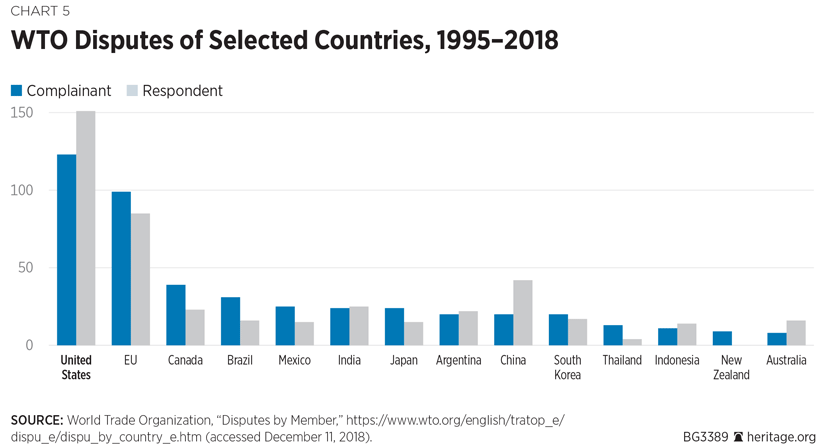
While the Administration defends its aggressive WTO policy as needed to spearhead a discussion on reforming the entire dispute-settlement system—which, admittedly, takes years to resolve individual disputes even though it should not take longer than 15 months—it does risk alienating other WTO members and undermining U.S. leadership at the organization. That would be unfortunate for a country that has historically led the economic and trade liberalization enshrined in the Washington Consensus.
Impact of Protectionism on U.S. Monetary Policy
Imposing tariffs on too many imports can also cause extra headaches for the U.S. Federal Reserve and lead to higher inflation.REF Higher inflation requires the imposition of higher interest rates to avoid overheating the economy, but that is only part of the problem. As former Federal Reserve Chairman Alan Greenspan once noted, “uncertainty is not just an important feature of the monetary policy landscape; it is the defining characteristic of that landscape.”REF
The Trump Administration’s tariffs could exacerbate this uncertainty in various ways: For example, it is still unclear which portion of any tariff levied would be borne by U.S. consumers through higher prices, or how the U.S. government will use the extra tariff revenues (whether it will simply spend them or instead use them to reduce future borrowing), or how other countries will retaliate and how the resulting global trade uncertainty might actually (and perversely) strengthen the U.S. dollar and make U.S. exports less competitive globally. Adding to the trouble is the fact that there is relatively scant historical data available on trade wars that could guide the Federal Reserve in its decision making.
If the Fed gets the monetary policy wrong, it may cause either too much inflation or an unnecessary contraction that would crimp economic growth. The concept of “anchored” inflation expectationsREF—which has been in place since the 2008 financial crisis—is a key element of current Fed monetary policy. It is thus quite possible that new tariffs will “unanchor” those inflation expectations and wreak havoc on heretofore smooth and predictable U.S. monetary policy, as losing control over the expectations might force the Fed to resort to unpredictable, “whatever-it-takes” measures.REF Given that tariffs will increase inflation pressures in any case due to rising prices, the Fed could thus easily overshoot its monetary tightening, choking growth by raising interest rates higher than would be appropriate for the true state of the U.S. economy.
Is President Trump’s Real Goal to Expand Free Trade?
Some of President Trump’s most ardent defenders argue that tariffs are a means to achieve two policy goals at once: to weaken Chinese President Xi Jinping’s “Made in China 2025” programREF and to extract commitments from EU member states to ramp up defense spending. That might have also been the goal of President Trump’s meeting with the EU Commission President Juncker in the White House in July 2018—to extract concessions from the EU, such as dropping its own 10 percent tariff on selected U.S. vehicles, in exchange for a more forthcoming approach towards tariffs.REF
The United States cannot wage trade wars against the EU and China at the same time, however, without putting into jeopardy the foundations of American prosperity. In order for the U.S. to pressure the retrograde Chinese leadership, confront its state capitalism, and force Beijing to respect intellectual property rights (to name a few of the sources of trade tensions—problems that the U.S. and EU share) the U.S. should have the EU at its side as a strong ally, not as an adversary sitting across a trade negotiating table.REF This is a reality that would argue for resolving the U.S. problems with the EU first and then taking on China without distractions or opposition from the EU.
Better Alternatives: “Zero-Zero-Zero” and Other Recommendations
There are several ways to go about achieving the goal of resolving U.S.–EU trade issues. The first option would be to negotiate the “tariff-free, zero-zero-zero zone” with G7 countries that President Trump raised at the June 2018 G7 meeting in Canada.REF Transatlantic industrial tariffs are already quite low, so pushing them to zero would not be a herculean task, and if those talks are successful, they would serve to jump-start talks to resolve additional disputes, such as in agriculture. They would also send a strong and positive signal to the rest of the world.
A better and perhaps more realistically achievable course of action in the short term would be what some EU diplomats have informally proposed—to revive parts of the abandoned TTIP talks. Several separate “sectoral” agreements could conceivably be broken out of those original TTIP chapters—those that were the least controversial and most likely to be concluded successfully—and adopted. Examples of successful, limited-scope U.S.–EU agreements already exist, for instance, in the area of pharmaceuticalsREF and outer space.REF More such progress is possible in other sectors, such as automobiles, while the effectiveness of existing U.S.–EU mutual recognition agreements (MRAs) can also be improved. Indeed, many of the original TTIP goals are included in the “United States-European Union Negotiations: Summary of Specific Negotiating Objectives” document that was published by the Trump Administration in January 2019.REF
With regard to the EU’s harassment of Silicon Valley and other American high-tech companies via the GDPR and other means, the U.S. could take measures, such as barring the payment by U.S. firms of fines imposed on them for violations (real or purported) of EU data-protection rules pending a comprehensive settlement of this international dispute on the basis of the principle that data are governed by the flag under which they rest. This bar could be imposed on the basis that EU financial penalties are excessive, and that the EU has no right to exert extraterritorial jurisdiction in the United States.
In order to protect the U.S. from the EU’s pending copyright law, Congress could allow U.S. courts to impose punitive fines on bogus or excessive EU copyright complaints made under the law against U.S. companies or persons—pending a wider U.S.–EU agreement on copyright that is grounded in protecting the legitimate interests of content creators, publication platforms, and private individuals.
Conclusion
President Trump is clearly trying to fulfill his election promises to his core “forgotten” electorate—to bring industrial jobs back to the U.S., to get “tough” on trade, and to negotiate “better” trade deals for America. However, some of his actions to fulfill those promises are beginning to inflict damage on the U.S. as well as other countries. Tariffs mean less competition, which in turn means higher prices, narrower choices, and lower product quality for the consumer. There were many factors at work in the loss of manufacturing jobs in the Upper Midwest—including bad company management, over-aggressive and short-sided union bargaining, oppressive government tax and regulatory policies, automation, and the lack of upgraded job skills. Blaming those problems on foreign competition will not solve them.
Ultimately, not only the U.S. but the entire transatlantic community stands to lose from a full-fledged trade war. In advanced economies, everyone can win from freer trade and lower tariffs. Free trade motivates businesses to compete by continuously improving their products and offering them for the lowest possible prices, giving the consumer a win-win choice among a greater variety of higher-quality goods for lower prices. Trade barriers and tariffs merely create a climate in which non-competitive economic sectors with cronyist political connections can thrive on the backs of consumers and hinder optimal economic performance.
Free trade, by definition, creates dependencies on foreign countries. But these dependencies are mutual. As much as the U.S. may rely on other countries for certain products, those same countries will rely on the U.S. for other goods and services. The trade skirmishes provoked by the Trump Administration can further spill over into the political sphere and erode transatlantic cooperation at a time when global authoritarianism and anti-democratic forces are on the rise.
To achieve freer transatlantic trade, the Administration should continue negotiations with the EU aimed at achieving some immediate wins for both sides, then pursue an agreement to lower tariffs and reduce non-tariff barriers, while also launching a joint U.S.–EU effort to reform the WTO. But the higher growth and lower prices that free trade will bring will be blunted—if not reversed—if the EU continues on its path of “behind the border” protectionism and if it continues to export its low-growth model to other nations.
Both Americans and Europeans will be well served by their governments if they reach an agreement to generate more free trade, which will lead to greater consumer choice at the best prices and highest quality—on both sides of the Atlantic.
—James M. Roberts is Research Fellow for Economic Freedom and Growth in the Center for International Trade and Economics, of the Kathryn and Shelby Cullom Davis Institute for National Security and Foreign Policy, at The Heritage Foundation. Ivan Beňovič, a participant in the 2013 Heritage Young Leaders Program, is an analyst at the International Investment Bank. He holds an MA from the Johns Hopkins School of Advanced International Studies and was previously a policy analyst in the Ministry of Finance of the Slovak Republic.
